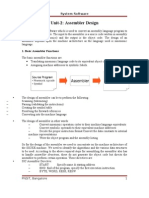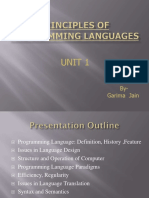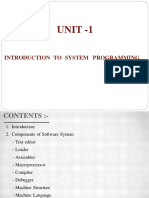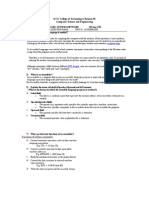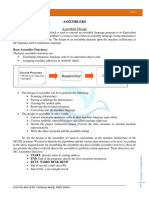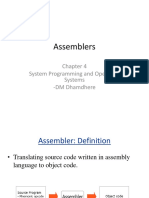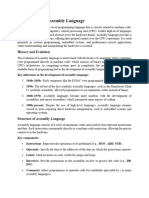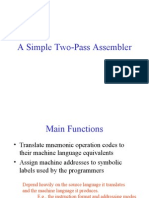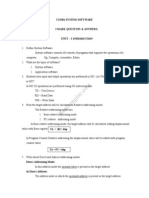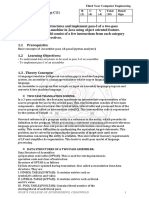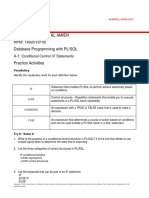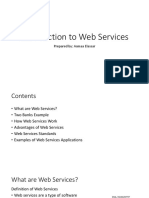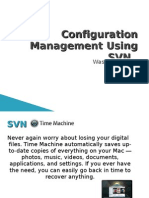Mod 2 Notes
Mod 2 Notes
Uploaded by
joshuajohn8281Copyright:
Available Formats
Mod 2 Notes
Mod 2 Notes
Uploaded by
joshuajohn8281Original Description:
Original Title
Copyright
Available Formats
Share this document
Did you find this document useful?
Is this content inappropriate?
Copyright:
Available Formats
Mod 2 Notes
Mod 2 Notes
Uploaded by
joshuajohn8281Copyright:
Available Formats
CST 305 System Software
Module 2 (Assembly Language Programming and Assemblers)
SIC/XE Programming, Basic functions of Assembler, Assembler output format – Header, Text
and End Records. Assembler data structures, Two pass assembler algorithm.
Assemblers
At one time, the computer programmer had at his disposal a basic machine that interpreted,
through hardware, certain fundamental instructions. He would program this computer by writing
a series of 1’s and 0’s (machine language), place them into the memory of the machine, and
press a button, whereupon the computer would start to interpret them as instructions.
Programmers found it difficult to write or read programs in machine language. In their quest for
a more convenient language they began to use a mnemonic (symbol) for each machine
instructions, which they would subsequently translate into machine language. Such a mnemonic
machine language is now called an assembly language. Programs known as Assemblers were
written to automate the translation of assembly language into machine language. The input to an
assembler program is called source program. The output is a machine language translation called
object program.
Basic Assembler functions
• Convert symbolic operands to their equivalent machine addresses (eg: RETADR to
1033)
• Convert mnemonic operation codes to their machine language equivalents (eg: STL to
14)
• Convert the data constants specified in the source program into their internal machine
representations (eg: EOF to 454F46)
Ms. Anna N Kurian, Asst. Prof., Dept. of CSE, SJCET, Palai 1
CST 305 System Software
• Write the object program and the assembly listing
• Build the machine instruction into proper format
Assembler Directive
An assembler directive is a set of instructions used to instruct the assembler to perform certain
actions during the assembly of the program. This statement neither represents machine
instructions that are to be included in the object program nor indicate the storage allocation of
constants or variables. It directs the assembler to take certain actions during the process of
assembling a program. START, END, BYTE, WORD, RESW, RESB, BASE, EQU, ORG,
LTORG are some of the assembler directives.
1. START : Specify name and starting address for the program
eg: COPY START 1000
2. END : Indicate the end of the source program and (optionally) specify the first executable
instruction in the program
eg: END FIRST
There are four different ways of defining storage for data items in the SIC Assembler language:
1. BYTE : Generate character or hexadecimal constant, occupying as many bytes as needed
to represent the constant
– Eg: CHARZ BYTE C’Z’
2. WORD : Generate one-word integer constant
– Eg: FIVE WORD 5
3. RESB : Reserve the indicated number of bytes for a data area
– eg: C1 RESB 1
4. RESW : Reserve the indicated number of words for a data area
– eg: ALPHA RESW 1
Example of a SIC Assembler language program
Ms. Anna N Kurian, Asst. Prof., Dept. of CSE, SJCET, Palai 2
CST 305 System Software
Figure shows an assembler language program for the basic version of SIC. Line numbers are
given only for reference and are not the part of the program. Then there are labels defined by the
programmer. Then mnemonic instructions (opcode) eg: STL, JSUB. Indexing addressing is
indicated by adding modifier “X” (line 160). Then comments are represented by “.”
The program contains a main routine that reads records from an input device, identified by
device code F 1 and copies them to an output device 05. Main routine calls subroutine RDREC
to read a record into buffer and another subroutine WRREC to write the record from the buffer to
the output device. Each subroutine must transfer the record one character at a time because the
only I/O instructions available are RD and WD. The buffer is necessary: because the I/O rates for
Ms. Anna N Kurian, Asst. Prof., Dept. of CSE, SJCET, Palai 3
CST 305 System Software
two devices, such as a disk and a slow printing terminal, may be different. The end of each
record is marked with a null character (hexadecimal 00).
If a record is longer than the length of a buffer (4096 bytes), only the first 4096 bytes are
copied.(for simplicity, the program does not deal with the error recovery when a record
containing 4096 bytes or more is read. The end of the file to be copied is indicated by a zero-
length record. When the end of file is detected, the program writes EOF on the output device and
terminates by executing an RSUB instruction. Assumed that the this program was called by the
operating system using a JSUB instruction and thus the RSUB will return the control to the
operating system
Forward Reference
Convert symbolic operands to their equivalent machine addresses (eg: RETADR to 1033). This
cannot be achieved in the sequential processing of the source program, one line at a time. This
poses a problem : Forward Reference
Forward Reference – a reference to label (RETADR) that is defined later in the program. If we
attempt to translate the program line by line, we will unable to process this statement because we
do not know the address that will be assigned to RETADR. Because of this, most assemblers
make two passes over the source program.
• PASS 1:
– Scan the source program for label definitions and assign addresses (such as the
Loc column)
• PASS 2:
– Performs the actual translation
Ms. Anna N Kurian, Asst. Prof., Dept. of CSE, SJCET, Palai 4
CST 305 System Software
Assembler Output Format
Finally, the assembler must write the generated object code onto some output device. The object
program will later be loaded into memory for execution. The simple object program format uses
3 types of records: Header, Text and End.
• Header record contains the program name, starting address and length.
• Text records contain the translated (ie., machine code) instructions and data of the
program, together with an indication of the addresses where these are to be loaded.
• End record marks the end of the object program and specifies the address in the program
where execution is to begin.
Ms. Anna N Kurian, Asst. Prof., Dept. of CSE, SJCET, Palai 5
CST 305 System Software
Ms. Anna N Kurian, Asst. Prof., Dept. of CSE, SJCET, Palai 6
CST 305 System Software
Figure below shows the sample object program generated for the above given simple SIC
assembly program.
To avoid confusions, we have used he term column rather than byte to refer to positions within
object program records. This is not meant to imply the use of any particular medium for the
object program. “^” used to separate fields visually and is not present in the actual object
program. Note there is no object code corresponding to the addresses 1033- 2038 → this storage
is simply reserved by the loader for use by the program during execution.
Passes of Assembler
A Pass is defined as the processing activity of every single statement in the source code to
perform a set of language processing functions. Pass can also be defined as the activity of
scanning the assembly language programming.
• Single pass Assembler: The assembler scans the entire source program (assembly
language program) once and convert into an object code.
Ms. Anna N Kurian, Asst. Prof., Dept. of CSE, SJCET, Palai 7
CST 305 System Software
• Multi-pass Assembler: The translation of assembly language program into object code
requiring many passes.
The breaking of the entire assembly process into passes makes design simpler and enables better
control over the subtasks and intermediate operations.
Functions of Two Passes of Assembler
• PASS 1 (Define symbols)
– Assign addresses to all statements in the program
– Save the values (addresses) assigned to all labels for use in Pass 2
– Perform some processing of assembler directives. (This includes processing that
affects address assignment, such as determining the length of data areas defined
by BYTE, RESW, etc.)
• PASS 2 (Assemble instructions and generate object program)
– Assemble instructions (translating operation codes and looking up addresses)
– Generate data values defined by BYTE, WORD, etc.
– Perform processing of assembler directives not done during Pass 1
– Write the object program and assembly listing
Assembler Data Structures
Simple Assembler uses two major internal data structures:
– Operation Code Table (OPTAB)
– Symbol Table (SYMTAB)
Also need a variable Location Counter (LOCCTR).
OPTAB
Ms. Anna N Kurian, Asst. Prof., Dept. of CSE, SJCET, Palai 8
CST 305 System Software
OPTAB is used to look up mnemonic operation codes and translate them to machine language
equivalents. This must contain at least mnemonic operation code and its machine language
equivalent. In more complex assemblers, this table also contains information about instruction
format and length. During Pass 1 OPTAB is used to look up and validate operation codes in the
source program. In Pass 2, it is used to translate the operation codes to machine language.
In case of SIC/XE machine that has instruction of different length. We must search OPTAB in
the first pass to find the instruction length for incrementing LOCCTR. In second pass, the
information from OPTAB tell us which instruction format to use in assembling the instruction,
and any peculiarities of the object code instructions (typically most real assemblers).
OPTAB is usually organised as a hash table, with mnemonic operation code as the key. This
information in OPTAB is predefined when the assembler itself is written, rather than being
loaded into the table at the execution time. This hash table organisation provides fast retrieval
with a minimum of searching. OPTAB is static table – entries are not normally added to or
deleted from it.
SYMTAB
SYMTAB is used to store values(address) assigned to labels. SYMTAB includes the name and
value(address) for each label in the source program, together with flags to indicate error
conditions(eg: a symbol defined in two different places).The table may contain other information
about the data area or instruction labelled (eg: it’s type or length). During Pass 1 , the labels are
entered into SYMTAB as they are encountered in the source program, along with their assigned
addresses (from LOCCTR). During Pass 2, symbols used as operands are looked up in SYMTAB
to obtain the addresses to be inserted in the assembled instructions
SYMTAB is usually organised as hash table for efficiency in insertion and retrieval. Entries are
rarely deleted from this table. Programmers often select many labels that have similar
characteristics (eg: label start or end with the same characters , like LOOP1, LOOP2,
LOOPA,...or are of same length like A, X, Y, Z). Hashing function selected should perform well
with such non random keys. Care should be taken in the selection of hashing function because
the SYMTAB is used throughout the assembly. Good option is the selection of hash function
which divides the entire key by a prime table length.
Ms. Anna N Kurian, Asst. Prof., Dept. of CSE, SJCET, Palai 9
CST 305 System Software
LOCCTR
LOCCTR is a variable that is used to help in the assignment of addresses. LOCCTR is initialized
to the beginning address specified in the START statement. After each source statement is
processed, the length of the assembled instruction or data area to be generated is added to
LOCCTR. Thus whenever we reach a label in the source program, the current value of LOCCTR
gives the address to be associated with that label.
Assembler Algorithm
Both passes of the assembler reads the original source program as input. However, there is
certain information (such as location counter values and error flags for the statements) that can or
should be communicated between the two passes. Pass 1 usually writes an intermediate file that
contains each source statements together with its assigned address, error indicators etc. This file
is used as input to Pass 2. Means this working copy of the source program(intermediate file) can
also be used to retain the results of certain operations that may be performed during Pass 1 (such
as scanning the operand field for symbols and addressing flags), so these need not be performed
again during Pass 2. Similarly, pointers into OPTAB and SYMTAB may be retained for each
operation code and symbol used.
Algorithm explains the logic flow of two passes of assembler. Apply the algorithm to source
program (assembly language) to generate object program. For simplicity, we assume that source
lines are written in the fixed format with fields:
LABEL OPCODE OPERAND
If one of these fields contains a character string that represents a number, we denote its numeric
value with a prefix #. (eg: #(OPERAND))
Ms. Anna N Kurian, Asst. Prof., Dept. of CSE, SJCET, Palai 10
CST 305 System Software
Ms. Anna N Kurian, Asst. Prof., Dept. of CSE, SJCET, Palai 11
CST 305 System Software
Ms. Anna N Kurian, Asst. Prof., Dept. of CSE, SJCET, Palai 12
You might also like
- System Software Notes 5TH Sem VtuDocument40 pagesSystem Software Notes 5TH Sem VtuNeha Chinni89% (19)
- Assembler Linker LoaderDocument64 pagesAssembler Linker LoaderYaminiNo ratings yet
- Cs 303 System SoftwareDocument67 pagesCs 303 System SoftwareAnamikaNo ratings yet
- 2.1basic Assemblers FunctionsDocument15 pages2.1basic Assemblers FunctionsChanchal Rawat100% (1)
- Assembler DesignDocument40 pagesAssembler DesignAdilyt yttNo ratings yet
- System Programming NotesDocument110 pagesSystem Programming Notestan100% (3)
- Unit1 130131031436 Phpapp01 PDFDocument47 pagesUnit1 130131031436 Phpapp01 PDFRohit JoshiNo ratings yet
- Chapter Two - AssemblerDocument21 pagesChapter Two - AssembleramanuelNo ratings yet
- Unit 1Document58 pagesUnit 1sefeb65570No ratings yet
- Final Te 2019 Sposl Lab Manual 2022-4-33Document30 pagesFinal Te 2019 Sposl Lab Manual 2022-4-33patilkalpesh6289No ratings yet
- KCG College of Technology, Chennai-96 Computer Science and EngineeringDocument14 pagesKCG College of Technology, Chennai-96 Computer Science and EngineeringSwarnendu GhoshNo ratings yet
- Module 2Document14 pagesModule 2parekh.divy2911slideshareNo ratings yet
- Experiment No1to13Document97 pagesExperiment No1to13Virendra JopleNo ratings yet
- Programming Language HandoutDocument75 pagesProgramming Language HandoutDr Narayana Swamy RamaiahNo ratings yet
- Module 2Document56 pagesModule 2Khushi SinhaNo ratings yet
- SPCC - 2Document14 pagesSPCC - 2Ian ThomasNo ratings yet
- Unit 2 SPDocument29 pagesUnit 2 SPKumar KumarNo ratings yet
- AssemblersDocument48 pagesAssemblersAnkurNo ratings yet
- 7 Introduction To Assembly LanguageDocument5 pages7 Introduction To Assembly Languagerkeditors47No ratings yet
- Module 2Document81 pagesModule 2Sudeeksha GanguliNo ratings yet
- IntroductionDocument26 pagesIntroductionHitesh Bhati0% (1)
- Unit 3 RTOSDocument37 pagesUnit 3 RTOSNikhathNo ratings yet
- Unit 2Document28 pagesUnit 2xboyxman1000No ratings yet
- Simple Pass2 AssemblerDocument28 pagesSimple Pass2 Assemblerjyotsna63% (8)
- Unit2 Assebly-ProgDocument5 pagesUnit2 Assebly-Progdon1298567No ratings yet
- Unit - I: Cs2304-System SoftwareDocument10 pagesUnit - I: Cs2304-System SoftwareNandha KumarNo ratings yet
- 2 Programmer View of Computer and Instruction CycleDocument45 pages2 Programmer View of Computer and Instruction Cycleemansheraz7No ratings yet
- Adv C3Document53 pagesAdv C3Ankita Miglani SainiNo ratings yet
- Lec#1Document36 pagesLec#1defenders of the skyNo ratings yet
- MIC Unit-2 NotesDocument21 pagesMIC Unit-2 NotesGaurang RaneNo ratings yet
- Good Questions To Ask AssemblyDocument12 pagesGood Questions To Ask AssemblyAbdul Qadeer Khan100% (1)
- R.V. College of EngineeringDocument34 pagesR.V. College of EngineeringPunith RaajNo ratings yet
- Assembler BasicDocument24 pagesAssembler BasicIlleana HolmesNo ratings yet
- System Programming Unit-1 by Arun Pratap SinghDocument56 pagesSystem Programming Unit-1 by Arun Pratap SinghArunPratapSingh100% (2)
- Language Translation: Programming ToolsDocument7 pagesLanguage Translation: Programming ToolsToni-Ann WillisNo ratings yet
- Assembler Pass1aDocument2 pagesAssembler Pass1ashravan kumbharNo ratings yet
- Compiler Unit - 1 PDFDocument16 pagesCompiler Unit - 1 PDFSarthak Singh ChandelNo ratings yet
- Language Processor NotesDocument4 pagesLanguage Processor NotesfinooshasvNo ratings yet
- Module-1 Part2 AssemblersDocument24 pagesModule-1 Part2 AssemblerssrinivasNo ratings yet
- 02 AssemblersDocument126 pages02 AssemblersNoha ElzaharNo ratings yet
- Esd Unit 3,4,5Document67 pagesEsd Unit 3,4,519-488 Karthik GoudNo ratings yet
- 8086 Microprocessor Programming & Instruction Sets:: Immediate AddressingDocument8 pages8086 Microprocessor Programming & Instruction Sets:: Immediate AddressingbiniamNo ratings yet
- Module 2&3Document127 pagesModule 2&3Mrs. SUMANGALA B CSENo ratings yet
- SPCCDocument24 pagesSPCCHisbaan SayedNo ratings yet
- Embedded Firmware (Unit - Iii)Document18 pagesEmbedded Firmware (Unit - Iii)jonnyNo ratings yet
- Directives? (JUN/JULY-14)Document9 pagesDirectives? (JUN/JULY-14)Binu KoshyNo ratings yet
- Compiler Theory: 001 - Introduction and Course OutlineDocument33 pagesCompiler Theory: 001 - Introduction and Course Outlinechidiume obiNo ratings yet
- Chapter 4 AssemblersDocument22 pagesChapter 4 AssemblersAditya Shah100% (1)
- Sposl Lab ManualDocument49 pagesSposl Lab Manualsujaypatil2004No ratings yet
- CHAPTER ONE - Introduction To System ProgrammingDocument7 pagesCHAPTER ONE - Introduction To System ProgrammingamanuelNo ratings yet
- Embedded Firmware (Unit - Iii)Document18 pagesEmbedded Firmware (Unit - Iii)Karthik MalipeddiNo ratings yet
- CompilerDocument84 pagesCompilerdebugger_ruetNo ratings yet
- System Software 2019Document17 pagesSystem Software 2019SudharshanNo ratings yet
- UNIT-5 Fundamentals of Information Technology (Question and Answers)Document15 pagesUNIT-5 Fundamentals of Information Technology (Question and Answers)Dr. S.K. SajanNo ratings yet
- Spos Lab ManualDocument41 pagesSpos Lab ManualAlbert Einstein100% (1)
- Lab 02: Getting Started With Turbo Assembler (TASM) : Objective(s)Document10 pagesLab 02: Getting Started With Turbo Assembler (TASM) : Objective(s)Google UserNo ratings yet
- Introduction To Assembly Language: AdvantagesDocument9 pagesIntroduction To Assembly Language: AdvantagesMuhammad Usman RafiqNo ratings yet
- "Unleashing the Power of Assembly Language: Mastering the World's Most Efficient Code"From Everand"Unleashing the Power of Assembly Language: Mastering the World's Most Efficient Code"No ratings yet
- Assembly Programming:Simple, Short, And Straightforward Way Of Learning Assembly LanguageFrom EverandAssembly Programming:Simple, Short, And Straightforward Way Of Learning Assembly LanguageRating: 5 out of 5 stars5/5 (2)
- Sad Chap 2Document8 pagesSad Chap 2nugusaiyasu4No ratings yet
- Finalversion 2Document24 pagesFinalversion 2Dipendu KumarNo ratings yet
- Constraints in OracleDocument16 pagesConstraints in OraclePrasanthi KolliNo ratings yet
- MagzReport Ramya.RDocument33 pagesMagzReport Ramya.RPoorni RenuNo ratings yet
- Assignment No#1 Question No 1: Describe How Many Types of Program Error Can Occur? Answer: Errors in C/C++Document2 pagesAssignment No#1 Question No 1: Describe How Many Types of Program Error Can Occur? Answer: Errors in C/C++Oxman BhattiNo ratings yet
- Tugas 4 - 1402018150Document14 pagesTugas 4 - 1402018150abdul aziz al-amienNo ratings yet
- Source CodeDocument6 pagesSource CoderabbarrabbarNo ratings yet
- Refactoring Auth - Objects SAP TM To TM in S4HANADocument24 pagesRefactoring Auth - Objects SAP TM To TM in S4HANASøren AndersenNo ratings yet
- GTHR DefaultDocument10 pagesGTHR DefaultPaulNo ratings yet
- Unit - I:: Overview of Computers and C-Programming Short Answer (2 Mark) QuestionsDocument21 pagesUnit - I:: Overview of Computers and C-Programming Short Answer (2 Mark) Questionslaxminayanan546No ratings yet
- User Defined Functions - Review Question SolutionDocument16 pagesUser Defined Functions - Review Question Solutionapurbabarman.mtbNo ratings yet
- Lect01 - Introduction To Web ServicesDocument15 pagesLect01 - Introduction To Web ServicesMohammed SaeidNo ratings yet
- Configuration Management Using SVNDocument21 pagesConfiguration Management Using SVNwaseembashirNo ratings yet
- SAP® Live Access: General User GuideDocument10 pagesSAP® Live Access: General User GuideHerawaty ArifinNo ratings yet
- Unit-2 Linear Data Structure-ArrayDocument27 pagesUnit-2 Linear Data Structure-ArraySanskruti DhananiNo ratings yet
- JCL TutorialDocument66 pagesJCL Tutorialmadhusudhan reddy100% (1)
- Programming MCQsDocument7 pagesProgramming MCQsAashish mauryaNo ratings yet
- ChainerDocument3 pagesChainerava939No ratings yet
- Chapter 4Document3 pagesChapter 4api-267045641No ratings yet
- Illustrated Microsoft Office 365 and Access 2016 Comprehensive 1st Edition Friedrichsen Test BankDocument23 pagesIllustrated Microsoft Office 365 and Access 2016 Comprehensive 1st Edition Friedrichsen Test Banktannerwebsterycspnfjtem100% (35)
- Lecture 15 - Addressing ModesDocument4 pagesLecture 15 - Addressing ModesPragya SinghNo ratings yet
- Interview QuestionsDocument47 pagesInterview QuestionsSantpa TechnologiesNo ratings yet
- BPS6 - Report Engine Scalability and PerformanceDocument5 pagesBPS6 - Report Engine Scalability and PerformanceLilyNo ratings yet
- Crack Your Angular Interview PDFDocument67 pagesCrack Your Angular Interview PDFAmir Karacic100% (2)
- Python3 Lesson 03Document20 pagesPython3 Lesson 03Ananda SaikiaNo ratings yet
- Simple Object Access Protocol FileDocument13 pagesSimple Object Access Protocol FilealwaronlineNo ratings yet
- Eecs Lab I: Javafx Graphs + Arduino: Material & Software NeededDocument7 pagesEecs Lab I: Javafx Graphs + Arduino: Material & Software NeededFrederic malungaNo ratings yet
- Creation of Database TableDocument34 pagesCreation of Database Tableanjali AnjuNo ratings yet
- 18isl67 New ST ManualDocument53 pages18isl67 New ST ManualSameer MilanNo ratings yet
- Bachelor of Information Technology (B.Sc. IT) Structural Query Language II November 2007Document5 pagesBachelor of Information Technology (B.Sc. IT) Structural Query Language II November 2007Dheeraj YadavNo ratings yet
